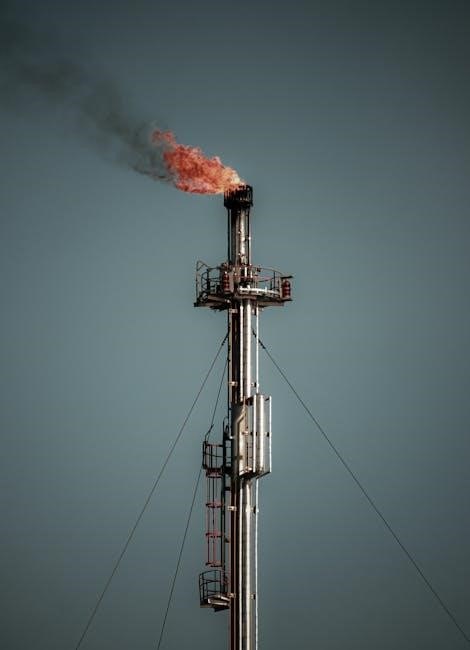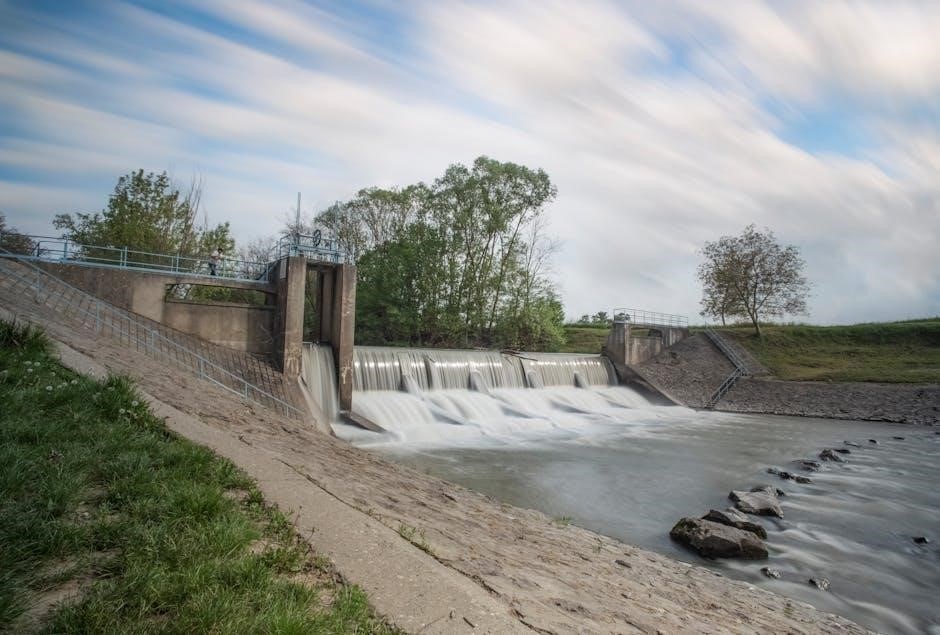Overview of “Pipeline” by Dominique Morisseau
Dominique Morisseau’s Pipeline, published in 2017, explores the school-to-prison pipeline’s impact on Black youth through Nya, a teacher, and her son Omari’s struggles in a flawed education system․
1․1․ Plot Summary
Pipeline, written by Dominique Morisseau, revolves around Nya, a dedicated high school teacher in New York City, and her son Omari, a teenager enrolled in a private school in upstate New York․ The play explores Nya’s struggle to protect Omari from the school-to-prison pipeline, a systemic issue disproportionately affecting Black youth․ Omari faces disciplinary actions at school, leading Nya to confront the harsh realities of racism and inequality in the education system․ As Omari navigates his identity between his private school upbringing and his urban roots, Nya grapples with her role as a mother and educator, desperate to save her son from a system designed to fail him․ The story unfolds with emotional depth, highlighting the urgency of addressing systemic injustices․
1․2․ Main Characters: Nya and Omari
Nya, a high school teacher in New York City, is a complex and flawed character․ She is dedicated to her students but struggles with burnout, smoking, and occasional drinking, barely holding her life together․ As a single mother, Nya is deeply invested in her son Omari’s future, fearing the systemic traps that could derail his life․
Omari, Nya’s teenage son, is smart and perceptive but filled with rage and confusion․ Enrolled in a private school, he grapples with his identity, caught between his privileged education and his urban roots․ His emotional turmoil reflects the struggles of Black youth navigating systemic inequality and societal expectations․
1․3․ Setting: Urban Education and Family Dynamics
The play is set in the challenging environment of an urban public high school in New York City, where Nya teaches, and a private school in upstate New York, where Omari studies․ This contrast highlights the disparities in education and opportunities for Black students․ The urban setting underscores the systemic struggles faced by communities of color, while the private school represents a space of privilege that Omari struggles to navigate․ The dynamics between Nya and Omari’s home life and their respective educational environments create a tense interplay between personal and societal challenges, emphasizing the emotional and cultural complexities of their world․

Themes in “Pipeline”
Pipeline explores the school-to-prison pipeline, systemic racism, and the struggles of parenting and identity, particularly for Black youth navigating educational and societal challenges․
2․1․ The School-to-Prison Pipeline
The play highlights how systemic inequalities in education disproportionately target Black students, funneling them into the criminal justice system․ Nya’s fear for Omari’s future underscores this reality, as private schools and urban communities present conflicting worlds․ Morisseau illustrates how zero-tolerance policies and biased discipline practices contribute to this pipeline, trapping vulnerable youth․ The struggle reflects broader societal failures in supporting marginalized students, emphasizing the need for systemic change to protect their futures․

2․2․ Racism and the Education System
Pipeline exposes the entrenched racism within the education system, highlighting how Black students face disproportionate discipline and limited opportunities․ Nya, as a teacher, witnesses systemic biases firsthand, while her son Omari navigates a private school that fails to understand his urban roots․ The play critiques how schools often criminalize Black youth, perpetuating cycles of inequality․ Morisseau portrays the emotional toll on families and the struggle to protect Black children from a system designed to fail them․ This theme underscores the urgent need for reform to create equitable educational environments where Black students can thrive without facing systemic racism․
2․3․ Parental Duty and Identity Struggles
Nya’s journey in Pipeline embodies the dual struggle of parental duty and identity, as she strives to protect her son Omari while balancing her career as a teacher․ The play portrays her relentless efforts to shield Omari from the school-to-prison pipeline, even as she grapples with her own identity as a Black woman and educator․ Omari’s identity struggle is equally poignant, torn between his private school education and his urban roots, leading to internal conflict and anger․ Morisseau’s portrayal highlights the emotional burden on Black parents to preserve their children’s futures while navigating systemic barriers, emphasizing the complexity of parenthood and self-discovery in a challenging world․

Character Analysis
Pipeline delves into the complex emotions and identities of its characters, exploring their struggles with race, education, and family dynamics through vivid, nuanced portrayals․ Nya and Omari’s journeys highlight the emotional depth and societal pressures faced by Black youth and educators in America, offering a poignant exploration of resilience and identity․ Morisseau’s characters are multidimensional, reflecting the real-life challenges of navigating systemic inequities while maintaining personal integrity and familial bonds․
3․1․ Nya: The Struggles of a Mother and Teacher
Nya, a dedicated public high school teacher, faces the dual challenges of her professional and personal life․ As an educator, she witnesses the systemic failures of the education system, while as a mother, she battles to protect her son Omari from the school-to-prison pipeline․ Her character embodies the exhaustion and resilience of Black women in America, striving to balance their roles as caregivers and advocates; Nya’s internal conflict reflects her deep love for Omari and her community, yet she struggles with the limitations of her power in a system designed against them․ Her story is one of both vulnerability and unwavering strength․
3․2․ Omari: The Turmoil of Adolescence and Identity
Omari, Nya’s teenage son, embodies the anguish of adolescence and identity conflict․ As a Black youth navigating a private school in upstate New York, he feels disconnected from his urban roots․ Smart and astute, Omari harbors rage and sensitivity, struggling to express his emotions․ His private school education clashes with his identity as a young Black man from the inner city, creating internal turmoil․ Omari’s relationship with Nya is strained, as he seeks understanding and connection while rebelling against her protective instincts․ His character highlights the challenges of adolescence amidst systemic oppression, capturing the vulnerability and resilience of a generation caught between worlds․
3․3․ Supporting Characters and Their Roles
The supporting characters in Pipeline play pivotal roles in exploring the complexities of the story․ Jasmine, Omari’s girlfriend, represents a connection to his emotional life and the challenges of young love․ Xavier, Nya’s ex-husband and Omari’s father, embodies the tension between paternal love and the struggles of co-parenting․ Other characters, such as Nya’s colleagues and Omari’s teachers, highlight the broader systemic issues within education․ These characters not only deepen the narrative but also underscore the societal pressures and personal conflicts faced by Nya and Omari․ Their interactions reveal the interconnectedness of individual struggles and the collective fight against systemic inequality․

Dominique Morisseau: The Playwright
Dominique Morisseau is a renowned playwright known for addressing systemic issues like race and education․ Her work in Pipeline reflects her commitment to storytelling and social justice․
4․1․ Background and Inspiration
Dominique Morisseau, a celebrated playwright, draws inspiration from her mother, a dedicated public school teacher․ Her experiences and observations of the education system influenced Pipeline, reflecting her deep understanding of the challenges faced by Black youth and educators․ Morisseau’s work is deeply rooted in her commitment to social justice, using theater as a medium to highlight systemic issues․ Her personal connection to education and her community provides authenticity to the narrative, making Pipeline a powerful exploration of race, identity, and the struggles within the American education system․
4․2․ Writing Style and Dramatic Techniques
Dominique Morisseau’s writing in Pipeline is marked by lyrical dialogue and poetic language, which evoke deep emotion and authenticity․ She seamlessly blends personal and political themes, creating a raw, unflinching portrayal of systemic inequality․ Morisseau employs dramatic techniques like verbal sparring and emotional intensity to highlight the inner turmoil of her characters․ Her encouragement of audience engagement, breaking traditional theater norms, adds a layer of immediacy to the performance․ The play’s ethical ambiguity challenges viewers to confront uncomfortable truths, making it a powerful commentary on race, education, and identity․ Morisseau’s style is both evocative and provocative, ensuring a lasting emotional impact․

Reception and Impact
Pipeline has garnered critical acclaim for its unflinching portrayal of systemic inequality, resonating deeply with audiences and sparking essential conversations about race, education, and identity․
5․1․ Critical Reviews and Accolades
Pipeline has received widespread critical acclaim for its powerful exploration of systemic inequality and emotional depth․ Reviewers praise Morisseau’s piercing eloquence and nuanced character development․ Ben Brantley of The New York Times hailed it as “emotionally harrowing” and “ethically ambiguous,” noting its ability to raise urgent questions about race, class, and education․ The play has been celebrated for its unflinching portrayal of the school-to-prison pipeline and its impact on Black youth․ Audiences and critics alike have lauded its ability to spark essential conversations, cementing its place as a significant work in contemporary theater․ Its thought-provoking narrative continues to resonate, making it a landmark piece in addressing systemic issues․
5․2․ Audience Response and Cultural Significance
Pipeline has deeply resonated with audiences, sparking emotional connections and critical conversations about race, education, and systemic inequality․ The play’s unflinching portrayal of the school-to-prison pipeline has struck a chord, particularly with communities of color, who see their experiences reflected on stage․ Audiences have praised its authenticity and ability to humanize the struggles of Black youth and families․ Culturally, Pipeline is significant for amplifying marginalized voices and challenging viewers to confront uncomfortable truths about America’s education system․ Its impact extends beyond the theater, fostering dialogue and inspiring advocacy․ Dominique Morisseau’s work continues to be celebrated for its ability to bridge art and activism, leaving a lasting impression on both audiences and society․

Resources for Further Study
The Pipeline PDF is accessible on Scribd․ Study guides and analysis tools are available on educational websites and theater resources․ Critical essays and interviews with Dominique Morisseau offer deeper insights․
6․1․ Where to Find the PDF Version
The PDF version of Pipeline by Dominique Morisseau can be found on platforms like Scribd, where it is available for download․ Additionally, the play was published in the December 2017 issue of American Theatre, which also offers a digital version․ Some theater websites and educational resources provide access to the script in PDF format, allowing readers to explore the play’s themes and characters in depth․ Ensure you access these materials from reputable sources to support the playwright and publishers․
6․2․ Study Guides and Analysis Tools
Study guides and analysis tools for Pipeline are readily available online, offering in-depth insights into the play’s themes, characters, and dramatic structure․ Platforms like Scribd and educational websites provide summaries, character analyses, and critical essays․ These resources help students and educators explore Morisseau’s exploration of the school-to-prison pipeline, racism, and familial struggles․ Additionally, analysis tools such as SparkNotes and LitCharts offer detailed breakdowns of scenes, motifs, and symbolisms․ These guides are invaluable for understanding the play’s socio-political context and its emotional depth, making them essential for both personal study and classroom discussions․
